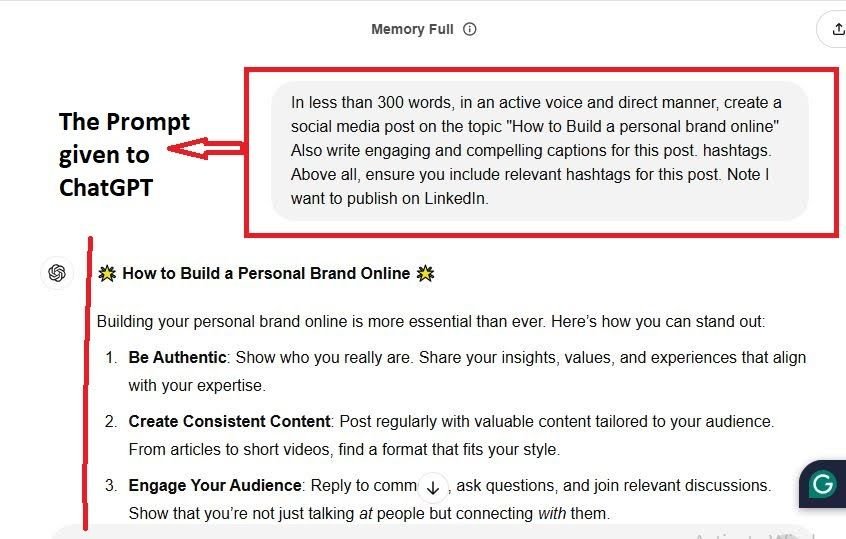
Image via Pexels
Who would have thought AI and content creation would become the best of allies?
Many years ago that would have been a mere prediction. But today it’s a glaring reality, as AI continues to disrupt content creation for many businesses.
In this article, you’ll learn:
- What is AI content creation?
- What is the role of AI in content creation?
- AI content creation for social media
- How to automate your social media posts
- Best Practices for Automated Social Media Posts
What Is AI Content Creation?
AI content creation is a strategy or process brands adopt to generate, optimize, and repurpose content using artificial intelligence tools and algorithms. Note this content could be written text, visual, or multimedia.
With the rise of AI, businesses or brands increasingly employAI technologies to create content that mimics human-written content.
Some of this content that businesses use AI to create include:
- Social media content/posts
- Website content
- Blog posts
- Articles
- Images
- Videos
What is the role of AI in content creation?
The role of AI in content creation is immense. First, it helps you to speed up the creation of content for your business on different platforms. That includes website content like blogs or articles, and posts for social media like LinkedIn, Facebook, and the like. AI tools can help correct the form of your content. AI can even generate content autonomously or help with ideation of relevant content, thus offering a creative boost.
Undoubtedly, AI is changing content marketing, as it influences nearly all content creation processes. For example, consider the task of SEO content writing, AI-powered tools like SEMrush, Ahref, and the like allow businesses to conduct keyword research and competitor analysis. This way, brands can create relevant content for their audience.
A survey estimates that the AI content creation tool market was worth $840.3 million in 2024. Companies now see the significance of adopting artificial intelligence in their business and the benefits of automating content creation.
To that end, AI in content creation increases efficiency and productivity. For example, AI tools like ChatGPT and Jasper.ai allow companies to create relevant text rapidly with some excellent prompts. Thus, AIdoesn’t preclude the creativity and professionalism of human writers, who are responsible for thoughtful prompts, for the underlying vision, and for applying a human filter on the responses.
AI Content Creation For Social Media
The Internet and various social media platforms thrive on content. Imagine what your favorite social media would become if no one created and published content.
Due to this revelation, most businesses, brands, and marketers continue to explore better ways and strategies to create relevant content for their audiences. In essence, most brands adopt AI content creation for social media, considering how it’s influencing content marketing.
Various players use AI content creation tools to generate, manage, and distribute content across various platforms.
Now the big question is:
What are the Roles of AI in Social Media Content Creation?
1. Automation of Content Generation
More than ever before, businesses and marketers can now use AI tools to automatically create social media posts, relevant captions, and images with just a few clicks and prompts.
The outcome? It reduces the time they spend on content creation. Most companies report saving 25% to 74% of time using Generative AI to create content.
2. Enhanced Creativity and Idea Generation
Brainstorming and developing content ideas for posts can sometimes be overwhelming. That’s why most business brands are more than grateful for AI content creation tools. Of course, these tools help them fix this challenge.
Amazingly, AI tools develop excellent content ideas by analyzing successful content trends. With this capability, businesses can produce engaging content and material that resonates with their audience.
3. Optimizing Performance
What’s the point of creating content without measuring their performance?
Neglecting performance monitoring may amount to wasted efforts and resources for businesses. Thus, content creation goes beyond writing and publishing content.
For example, when a company analyzes the engagement metrics for the content it creates, it gains actionable insights that help refine its content strategies.
Do you know the sweet part? Most social media platforms have built-in AI-powered capacity that provides businesses with analytics about their content. This way, companies and marketers have real-time data that allows them to tweak their content tactics in the future.
Hence, they can experiment with different types of content, posting times, and formats to see what yields the best results. Based on projections, the global market for Artificial intelligence in social media will hit $11.99 by 2031 with an annual growth rate of 28.7% from 2022 to 2031.
4. Content Repurposing
Social media thrives on content, though every platform has its unique attributes. For example, a video you create for YouTube (in most cases) may not qualify as a perfect video for Facebook or TikTok.
Thus, content repurposing is a strategy businesses use to maintain their content’s freshness while increasing its impact across diverse platforms.
The good news is that AI tools do this well with the right prompts, yet not without the finishing touch of competent human creators. In turn, businesses can repurpose their existing content into various formats suitable for social media platforms, without killing its value.
Now, you may ask: What are the practical ways you can employ to automate social media marketing efforts?
5 Steps to Automate Your Social Media Posts
Automating your social media posts can significantly enhance your business efficiency while consistently sharing valuable content online. Yet doing that remains a real challenge to most small medium-sized businesses (probably like yours).
With that in mind, we can’t adequately discuss automating your social media content creation without referencing social media automation tools.
1. Choose the Right Automation Tool
As mentioned, every business or brand that wants to automate its social media must adopt a specific implementation or system. And that makes selecting the right social media automation tool the first genuine step for you.
Essentially, there are many of these tools out there, but some popular options include:
- Sprout Social: As a tool for social media management, Sprout Social helps brands handle the scheduling of posts. Not only that, it offers a unique analytic feature that keeps track of engagement metrics.
- Buffer: Like Sprout Social, Buffer has a user-friendly interface and robust scheduling capabilities. You can check their website for more helpful information about them.
- Hootsuite: Out of the long list of social media automation tools, Hootsuite is another excellent tool. It provides extensive integration options and analytics.
- And others (You can check them out!)
2. Set Up Your Accounts
The next step is to set up your account since you’ve already picked a preferred tool to automate your social media. At this point, you integrate your social media accounts such as Facebook, LinkedIn, Instagram, and others into the chosen AI tool.
You can always find the hack on how to do this as most automation tools have step-by-step guides or tutorials to help you with the setup. If you can check this guide out if you eventually pick any of the tools below to automate your social media:
- How to Set up your account on Sprout Social
- How to Set up Your Account on Buffer
- How to Set up your account on HootSuite
3. Create a Content Calendar
The next thing to do is create a content calendar for your business. This way, you plan your content consistently and share valuable content with your audience to gradually achieve your business goals.
The fun part? Business owners don’t have to rack their brains over this because tools like ContentStudio can assist in visualizing your posting schedule.
4. Schedule Your Posts
Once you’ve mapped out a content plan for your social media, it’s time to utilize the scheduling feature of your chosen tool. This way, you set specific times for your posts to go live. But to do this, it’s best to consider your audience’s peak engagement times, which many tools can analyze for you.
Some tools allow you to upload multiple posts or schedule evergreen posts. Evergreen posts are those that brands can reuse over time to ensure ongoing engagement.
5. Use AI for Content Creation
As mentioned earlier, you can use AI tools to help generate engaging captions, hashtags, or images. For instance, tools like ChatGPT can assist in drafting social media copy for your brand, while you use platforms like Canva to create visuals.

Image via OpenAi, 2024
Beyond these five steps, it’s essential to check the analytics the automation tool you use provides. This way, you understand what content resonates with your audience and optimize future posts accordingly.
Of course, with this data, you can experiment with different types of content, posting times, and formats to see what yields the best results.
Best Practices for Automated Social Media Posts
While using automation in your social media offers enormous benefits to your brand, it can hurt your business at the same time when misused.
Hence, companies must follow core best practices to enjoy these benefits while maintaining authenticity.
Here are key strategies for effective social media automation:
1. Humanize Your Brand
While automation is good, you shouldn’t eliminate the human touch from your content because only human content can truly foster a genuine connection with your audience.
The reality? Your audience feels connected to your brand when your content feels relatable and personal.
2. Be Strategic with Scheduling
Constantly churning out content with the assistance of artificial intelligence tools is significant. But it’s best to be strategic when using scheduling tools. You want to post during peak engagement times specific to each platform.
This allows your content to reach your audience when they are most active. And, ultimately, that increases your content visibility and audience interaction with them.
3. Experiment with Content Variety
Every brand aims to keep its audience engaged and looking forward to future posts. And that’s why you should diversify your content types by mixing images, videos, polls, and text posts.
Take a fitness influencer for example. He could launch a series called “Monday Motivation Workouts,” where each week, he posts a new, quick routine to try. This way, followers know to look forward to a new workout every Monday.
4. Tailor Content for Each Platform
As mentioned before, each social network has unique characteristics and audience expectations. Hence, brands should tailor their messages, visuals, and hashtags for diverse social media accounts to enhance engagement.
5. Monitor Engagement in Real-Time
Businesses must actively monitor engagement to get the best from their social media marketing. That’s to say, it’s more than creating and scheduling posts for your social media. You need to respond promptly to your audience’s comments or messages. This way, you show that your brand values customer feedback.
Conclusion
Now you see the relationship between AI and content creation, and the significance of both to a business’s social media marketing efforts. On top of that, you’ve seen how you can automate your brand’s social media. With all that said, it’s critical that brands don’t allow automation to steal their brand voice, style, and identity. Brand health only thrives when human creators creatively keep things in check.
With these valuable insights under your belt, you can start leveraging the power of automation and AI today in your business. It all even makes business sense when you target the right audience. If you’re unsure how to go about that, you can read this article to learn how to find your target audience
